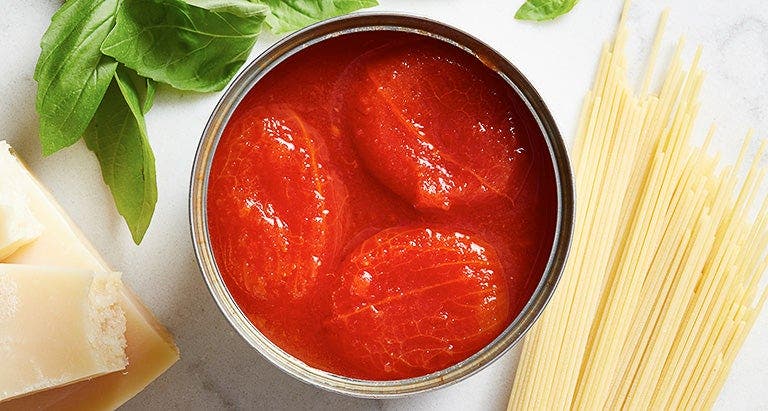Most Valuable Ingredient: Canned Tomatoes


A limited budget doesn't have to mean limited flavor. Our Most Valuable Ingredient series highlights those powerhouse products that are versatile, healthy, tasty and cheap, giving you the best bang for your buck.
At the height of tomato season, it's hard to imagine using the canned ones voluntarily. But canned tomatoes are ideal for cooking, they taste just as good as their fresh brethren (and sometimes even better), they're packed with nutrients and they're ready to use — no need to peel, seed or chop. Year-round, they're a Most Valuable Ingredient.
The Stats
Lycopene is the pigment that gives tomatoes their rosy hue, and is also a powerful antioxidant thought to reduce cancer risk, cardiovascular disease and macular degeneration. Studies have shown that the process of cooking makes the lycopene more readily usable by our bodies. And like raw tomatoes, canned ones are a good source of potassium and vitamin K and high in vitamins C and A.
Prices for canned tomatoes range from under a dollar for a 6-ounce can of tomato paste up to $5 for a 28-ounce can of whole peeled San Marzanos.
The Score
There are nearly as many varieties of canned tomatoes as there are seeds in a beefsteak. Most start with plum tomatoes, but processing yields different results. Here's a rundown of the most useful ones:
Whole peeled: These tomatoes have been peeled, then packed with either juice or purée (the label will specify which). The cans are heated to sterilize them, which also cooks the contents just a bit — that's why they're mushier than raw, fresh tomatoes. San Marzano tomatoes are a specific prized variety, grown in a particular region of Italy, but they're also a seed type grown in the United States and elsewhere. For the real Italian thing, look for the letters D.O.C. (denominazione di origine controllata) on the label — they cost more, but the flavor is unmatched.
Diced or crushed: They start out just like the whole ones but are then sent to a dicing machine, which chops, juices and seeds them. Again, these may be packed with juice or purée — but they come in more than just traditional cans: You might see them in aseptic cartons, which are heated and cooled much faster. The contents are still cooked, but the tomatoes retain their shape better, and some say they're fresher-tasting, too.
Purée: Taking diced one step further, these tomatoes have been cooked to a smooth, thick consistency. Tomato purée is most useful in soups, sauces and other dishes that will be cooked for a while, and recipes where you want tomato flavor but not texture.
Paste: This is purée that has been cooked down until it contains less than 20 percent of the water in a raw tomato. Use it to give a quick punch of deep tomato flavor and to thicken sauces. Since most recipes only call for a few tablespoons, look for tomato paste in tubes — store it in the fridge and you can use just a bit at a time. It might be more expensive upfront to buy it this way, but how many times have you thrown out half a can of tomato paste?
Flavored: These days, you'll see everything from fire-roasted to basil and garlic to green chili tomatoes. They're time-savers, since you won't have to peel and mince that garlic, but read labels carefully: More ingredients can mean more calories — and a higher Points value.
In Play
When buying, make sure cans are not dented — dents permit the growth of botulism. Technically, canned tomatoes will stay good indefinitely (as long as the can isn't bulging, which means it's spoiled), but for best quality, use within 12 to 18 months. Once opened, never store unused tomatoes in the can. Transfer to an airtight container and keep in the fridge for five to seven days. An exception is tomato paste in a tube which, refrigerated, lasts for months.
One classic use for canned tomatoes is pasta sauce: Sauté 3 minced cloves of garlic in olive oil until fragrant and golden. Add one 28-ounce can of crushed tomatoes and cook over medium-high heat for 15 minutes, stirring. Add 1 tablespoon of chopped basil leaves, salt and pepper, and cook 2 minutes more.
Diced tomatoes are perfect for salsa: Drain one 15-ounce can and combine with one small onion, diced, one jalapeño pepper, seeded and diced, 1/3 cup of chopped fresh cilantro, and salt and pepper.
